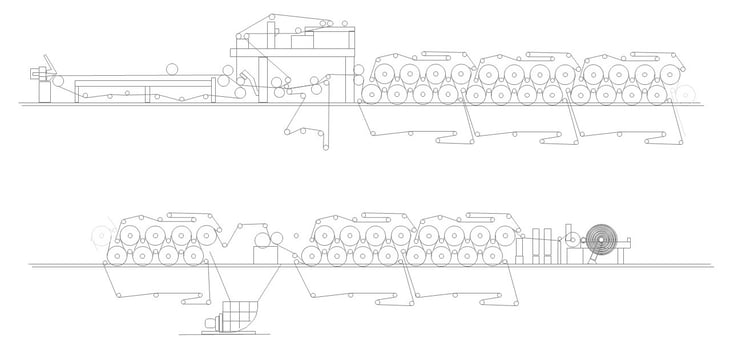In the last decade, the extraordinary expansion in the use of computer tools has led to an ever greater reduction in the use of graphic papers for written and illustrated communication, both mass and professional.
Today, in fact, the demand for these graphic and writing papers is mostly represented by market niches dedicated to special products such as, for example, papers dedicated to artistic activities, aesthetic packaging and some types of office papers.
The general reaction of the paper industry, to avoid the closure of many plants, was the conversion of machinery to adapt them to the production of the types of paper most requested by the current market.
Types of conversions
The general reaction of the paper industry, to avoid the closure of many plants, was the conversion of machinery to adapt them to the production of types of paper more in demand by the current market. Most of these conversions involved the transition to packaging paper production, including the liner and fluting necessary for the production of corrugated cardboard, due to the fact that demand for these products has grown strongly thanks also to the e-commerce.
However, the packaging paper market is characterized by low margins and conversion investments are justified only in the case of large and high productivity machines. Furthermore, the transition from the production of graphic papers, typically composed of pure cellulose, to packaging papers produced from recycled waste paper requires heavy interventions on the stock preparation plants. It is in fact necessary to implement the part of the process that concerns the purification of recycled fibers, not present on the original plants fed by cellulose.
Some customers, standing out from the crowd, have instead taken the more creative approach of converting continuous machines created for graphic papers to configurations suitable for the production of tissue paper, namely crepe papers for hygienic and sanitary use. These papers have the advantage of normally having a higher added value than wrapping papers, a factor that increases margins and improves the return on investment.
The conversion process to Tissue paper production
From a technical point of view, a plant for graphic papers and one for the production of tissue paper have many parts in common:
- Both can be fed with the same raw material, and this means that the stock preparation lines do not need impacting modifications
- The same headbox can be used, if the productivity of the machine does not change significantly
- The Fourdrinier wire in the formation area is typically suitable for medium-heavy tissue weights such as towel papers or table or sanitary support papers
- The multi-cylinder dryer section can be used in part to complete the drying of the sheet after creping
- The machine winder (Pope Reel), with any minor adjustments to improve the control of the winding pressure, is normally suitable for winding crepe papers.
The machine section that must undergo a radical transformation is that relating to the presses. In the conversion operation, the conventional press section of the graphic paper machine is completely replaced by a new press configuration typical of the tissue machine whose main element is a large steam-heated drying cylinder, called Yankee Dryer, which groups into a single element 3 fundamental stages of the tissue paper sheet production process:
- The pressing, through the contact between the press cylinders and the Yankee Dryer
- A first drying phase, thanks to the steam heating of the Yankee cylinder body and the external active hood
- The creping through which the sheet is forced to detach from the Yankee cylinder by means of a special creping blade.
As we have said, at least one of the group of drying cylinders of the original machine will be kept downstream of the Yankee press section in order to complete the drying of the crepe sheet. The remaining groups of dryers will instead be eliminated, while the winder will be moved back into the space left free. In this way, the new machine will be shorter and more compact than the original machine, with plenty of space in the area downstream of the winder.
In some cases, a slitting unit can be inserted between the last drying cylinder group and the winder, thanks to which it will be possible to divide the sheet into smaller formats that will be wound in as many coils centered on a single pole managed by the rewinder. This solution will make it possible to directly package marketable finished rolls, avoiding the passage on an off-line rewinding machine.
It is important to underline that, even in composing the new Yankee Dryer section, many of the components of the original press can be recovered. Among these we can mention:
- the suction press rolls
- The felt cylinders
- The guiding devices and felt stretchers
- Felt cleaning and conditioning devices
All this will help to reduce the investment on the conventional part of the press section to the supporting structure alone, thus concentrating the majority of the investment in the Yankee Dryer section consisting of the Yankee Dryer itself, the high efficiency hood and the related steam and aerothermal systems subservient to the two elements.
Finally, also as regards the management of process discontinuities (e.g. machine start-ups and sheet breaks), the existing equipment can be reused, in particular the under-the-machine pulpers and the broke treatment system.
The final result
In the image below, you can see the layout of a traditional graphic paper machine:

The final result, once the conversion process has been completed, will be a Tissue machine with the following layout:
_mod.jpg?width=1280&name=Schema%20Tissue%20machine%20(conversione)_mod.jpg)
For more information on how to convert your graphic paper plant into a Tissue plant, a process for which A.Celli has all the know-how and experience necessary to guarantee a first-rate result, request a free consultation with their experts.

